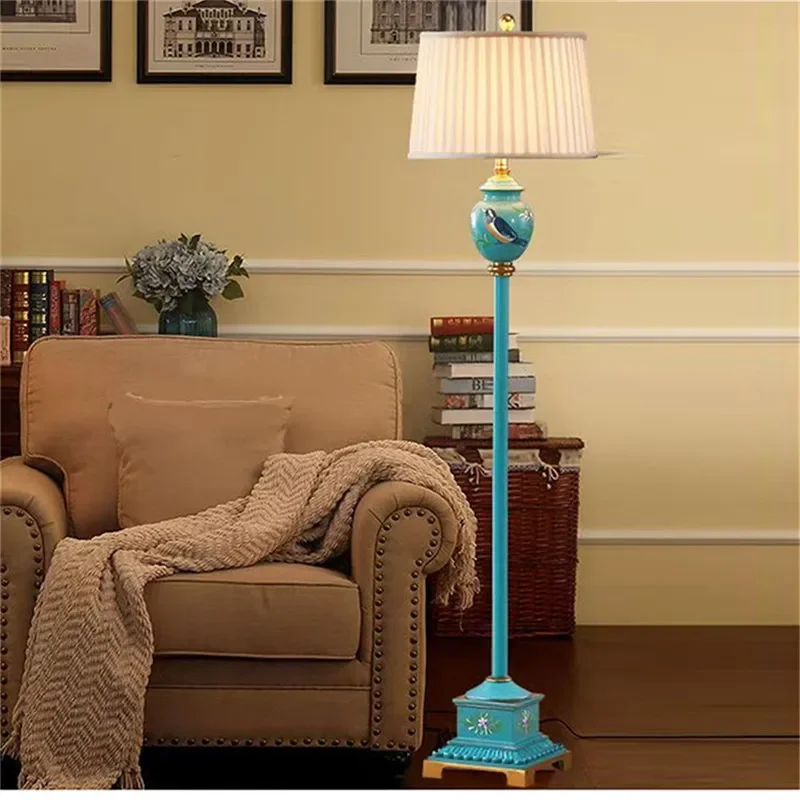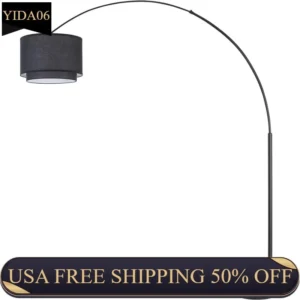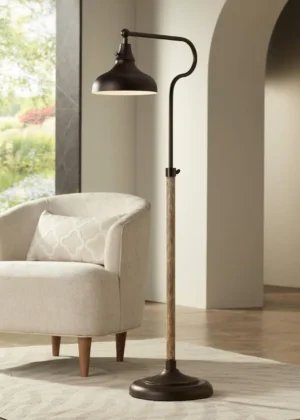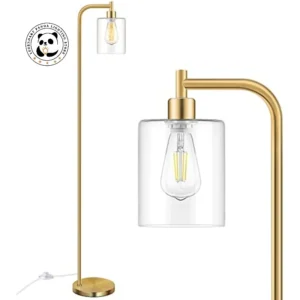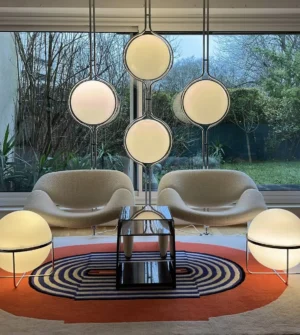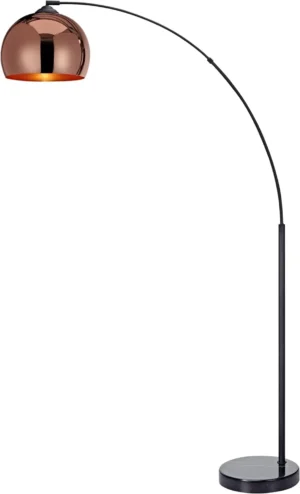Introduction to Arc Floor Lamps
Arc floor lamps stand out in the world of lighting fixtures with their distinctive curved arm that extends outward from a sturdy base. Unlike traditional floor lamps that shine light directly downward or upward, arc lamps provide overhead illumination without requiring ceiling installation. This unique design combines both form and function, making these lamps popular statement pieces in modern interior design.
The arc floor lamp’s history traces back to mid-century modern design movements of the 1960s. The iconic Arco lamp, designed in 1962, is largely credited with popularizing this distinctive style. With its marble base and arching stainless steel arm, it represented a revolutionary approach to floor lighting that continues to influence designs today.
What makes arc floor lamps so appealing is their versatility and visual impact. Typical arc lamps stand between 60-80 inches tall with an arc span of 30-45 inches, allowing them to reach over furniture pieces like sofas, dining tables, or reading chairs. This clever design eliminates the need for table space while providing directed light exactly where needed.
Beyond their practical benefits, arc lamps serve as architectural elements that draw the eye upward and create visual interest in a room. Their key features of arc floor lamps include dramatic curves, counterbalanced bases, and often adjustable components that allow for personalization of lighting direction and intensity.
As descendants of the mid-century design tradition, modern arc lamps have evolved to include various materials, finishes, and technological features while maintaining the core curved silhouette that defines them. Understanding these fundamental characteristics provides a foundation for selecting the right arc lamp for your specific needs and space.
Identifying Your Lighting Needs
Before selecting an arc floor lamp, it’s important to understand the type of lighting you need. Lighting generally falls into three main categories, and arc lamps can fulfill any of these functions depending on their design:
- Ambient lighting: General illumination that fills a room with soft, overall light
- Task lighting: Focused, brighter light for specific activities like reading or working
- Accent lighting: Decorative lighting that highlights architectural features or decor elements
The versatility of arc floor lamps means they can serve multiple lighting purposes simultaneously. For example, a lamp with a downward-facing shade over a reading nook provides task lighting, while also contributing to the room’s ambient light level.
When analyzing your room requirements, consider what activities take place in the space. A living room might need an arc lamp that casts a wide pool of light over a seating area (1000-3000 lumens depending on room size), while a home office might benefit from a more focused beam for desk work (400-700 lumens).
Light distribution patterns also matter significantly with arc lamps. Some designs create a concentrated pool of light directly beneath the shade, while others with translucent or open shades cast light in multiple directions. The angle and adjustability of the arc will determine where this light falls in your room.
Evaluating whether arc floor lamps will meet your needs requires honest assessment of your space and lighting goals. For instance, if you have low ceilings, certain tall arc lamps might feel overwhelming. Similarly, if you need highly directed task lighting that frequently changes position, a more adjustable desk lamp might be more practical than an arc floor lamp.
Room by room, arc lamps serve different purposes:
* Living rooms: Illumination over seating areas without table lamps taking up space
* Dining areas: Dramatic lighting over tables without permanent fixture installation
* Bedrooms: Elegant reading light that eliminates the need for bedside table lamps
* Home offices: Overhead task lighting without glare on computer screens
Understanding these functional requirements creates the foundation for selecting the right arc lamp, ensuring it will not only look beautiful but also serve your practical lighting needs effectively.
Size and Scale Considerations
Selecting an arc floor lamp with the right proportions is crucial for both functionality and visual harmony in your space. The lamp’s dimensions will determine how it fits within your room and how effectively it illuminates your desired area.
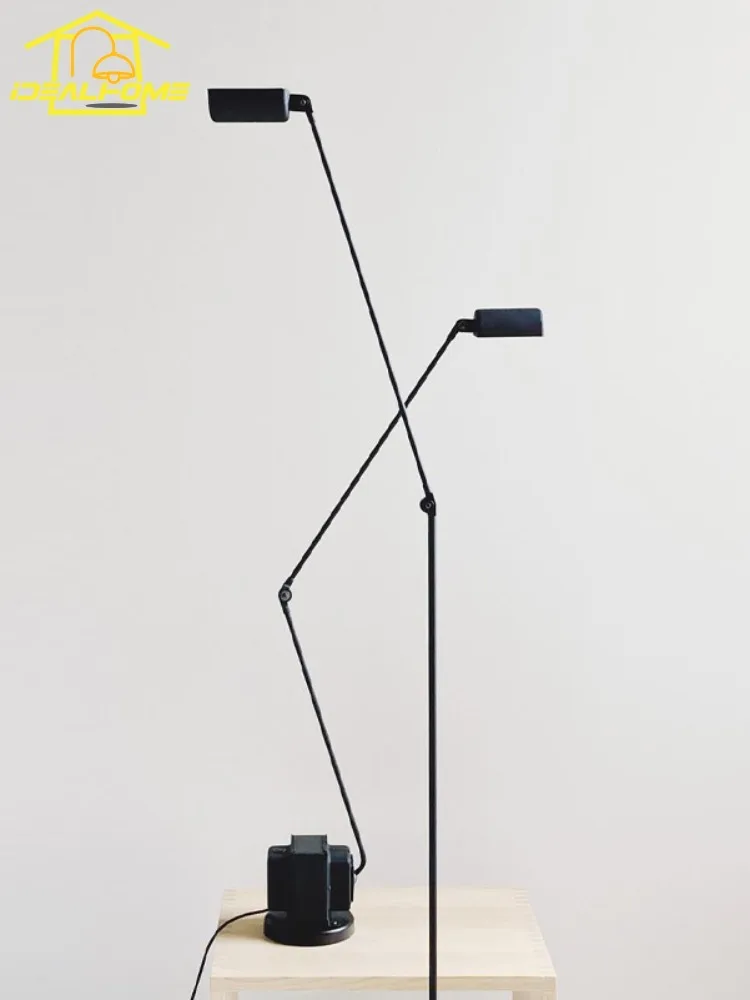
When measuring your space for an arc lamp, consider these key dimensions:
Total height: Most arc floor lamps stand between 60-80 inches (152-203 cm) tall. Ensure you have sufficient ceiling height, generally allowing at least 12-18 inches (30-45 cm) clearance above the highest point of the lamp.
Arc reach: Measure the horizontal distance from where you’ll place the base to where you want the light to fall. Standard arc spans range from 30-45 inches (76-114 cm). This measurement is critical when positioning the lamp to illuminate specific furniture like a sofa or dining table.
Base dimensions: Arc lamp bases typically measure 12-18 inches (30-45 cm) in diameter. Ensure you have adequate floor space for the base, especially in high-traffic areas where it could become a tripping hazard.
Shade size: The diameter of the lamp shade affects both the spread of light and the visual weight of the fixture. Larger shades generally provide wider light distribution but can appear bulky in smaller spaces.
Finding the right floor lamp height involves balancing these measurements with your specific room conditions. In rooms with standard 8-foot ceilings, arc lamps with heights around 60-70 inches work well. For higher ceilings, taller models can help maintain visual proportion.
When positioning near furniture, the bottom of the lamp shade should typically sit about 58-64 inches (147-163 cm) from the floor. For reading purposes, the bottom of the shade should be approximately 16-18 inches (40-46 cm) above the reading material and slightly behind or to the side of your shoulder to prevent glare.
For particularly spacious rooms or to create dramatic visual impact, larger oversized arc floor lamps can serve as stunning focal points. These statement pieces work best in rooms with higher ceilings and ample floor space to accommodate their grand scale.
Common sizing mistakes to avoid include:
* Selecting an arc that’s too short to properly reach over your furniture
* Choosing a lamp so tall it dominates the room or risks hitting the ceiling
* Underestimating the floor space needed for a properly weighted base
* Selecting a shade size disproportionate to your seating arrangements
By carefully considering these dimensional factors, you’ll ensure your arc lamp not only fits your space physically but also achieves proper balance with your existing furniture and architecture.
Materials and Construction Quality
The materials used in an arc floor lamp significantly impact its appearance, durability, weight, stability, and price point. Understanding these materials will help you select a lamp that meets both your aesthetic preferences and practical needs.
Base Materials
Marble/Stone: Marble bases provide excellent stability due to their substantial weight. They offer classic elegance and a premium feel, though they’re typically heavier (15-25 pounds or 6.8-11.3 kg) and more expensive. Marble base arc floor lamps remain popular for their timeless appeal and reliable stability.
Metal: Metal bases (often steel or cast iron) provide good stability with a more contemporary look. They’re generally lighter than stone but still substantial, making them easier to reposition. Metal bases typically feature wider footprints to compensate for their lighter weight compared to stone.
Weighted Composite Materials: These offer a balance between stability and affordability. Often designed to mimic the appearance of more expensive materials, composite bases can provide adequate weight at a lower price point, though they may not match the durability of solid materials.
Wood: Wood arc floor lamps bring natural warmth and texture to spaces. Wood bases are typically paired with metal arms and can range from light ash to rich walnut finishes. They work beautifully in spaces with other wooden elements or natural materials.
Arm Construction
The arc arm’s material and construction directly impact the lamp’s stability and durability:
Solid Metal: The most durable option, typically made from steel, aluminum, or brass. Higher-quality lamps feature seamless construction or well-finished joints.
Adjustable Mechanisms: Quality is reflected in smooth operation and secure locking mechanisms that prevent unwanted movement or drooping over time.
Internal Wiring: Better-quality lamps conceal wiring within the arm for a cleaner appearance and reduced risk of damage.
Shade Materials
Metal: Offers directional light with a contemporary industrial look. Durability is high, though they can create more harsh lighting.
Fabric: Provides diffused, softer lighting with textural interest. Quality varies significantly based on construction and fabric type.
Glass or Acrylic: Creates an elegant look with good light diffusion. Glass offers a premium appearance but adds weight to the arm.
Natural Materials: Rattan arc floor lamps and other natural fiber shades add organic texture and warmth while creating interesting light patterns through their woven structures.
Quality Indicators
When assessing construction quality, look for:
* Smooth, consistent finishes without flaws
* Substantial weight appropriate for the lamp’s size
* Stable connections between components
* Even seams and precise fittings
* Smooth operation of any moving parts
* UL or ETL safety certifications
Higher-quality materials generally translate to higher prices, but they also mean better stability, longer lifespan, and more refined aesthetics. The difference becomes particularly noticeable in adjustable features, which in lower-quality lamps may loosen or fail over time.
Matching Styles with Your Interior Design
Arc floor lamps come in a variety of design styles that can either complement your existing interior or serve as statement pieces that elevate your decor. Finding the right style match ensures your lamp enhances your overall design scheme rather than conflicting with it.
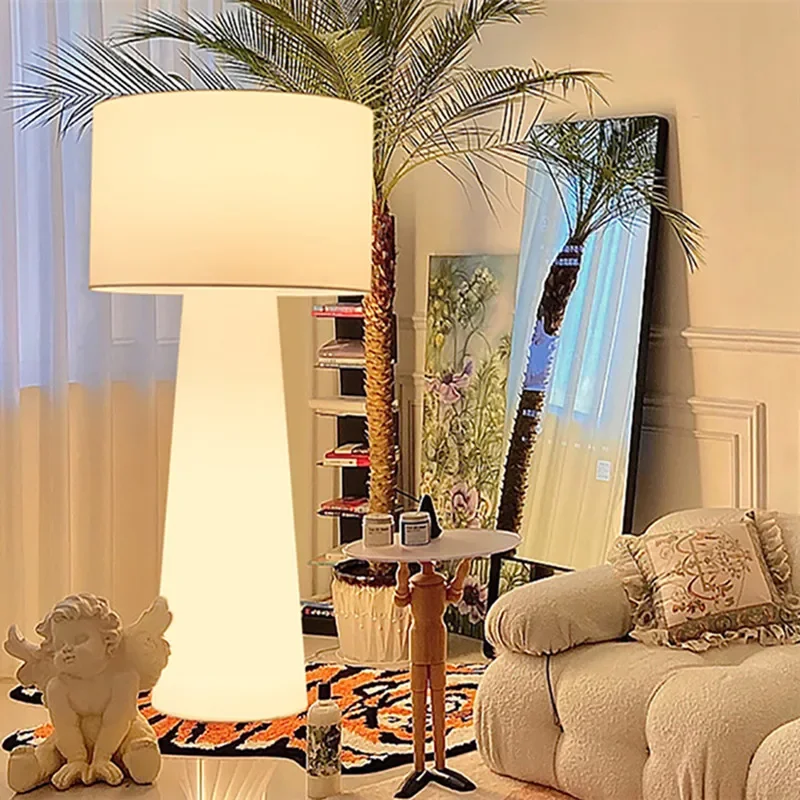
Modern/Contemporary Styles
Contemporary arc floor lamps feature clean lines, minimal ornamentation, and often incorporate materials like polished metals, glass, and simple neutral-colored shades. These lamps work excellently in:
* Minimalist interiors with uncluttered spaces
* Rooms with geometric furniture and abstract art
* Urban apartments and lofts with open floor plans
* Spaces featuring a neutral color palette with occasional bold accents
Contemporary arc lamps typically emphasize function alongside form, often incorporating adjustable features and energy-efficient lighting technology.
Mid-Century Modern Styles
Mid-century vintage arc floor lamps draw inspiration from the 1950s-1960s design era. These feature:
* Warm wood tones (teak, walnut, oak)
* Tapered legs or rounded organic shapes
* Brass or gold-toned metal accents
* Classic drum or cone-shaped shades
These lamps pair beautifully with furniture featuring tapered legs, organic shapes, and retro colors like mustard yellow, olive green, or burnt orange.
Industrial Styles
Industrial arc lamps emphasize raw materials and utilitarian design:
* Exposed hardware and mechanical elements
* Matte black or brushed metal finishes
* Edison bulbs or cage-style shades
* Heavier, more substantial bases
These work well in lofts, converted industrial spaces, or rooms that blend rustic and modern elements.
Natural and Organic Styles
Rattan arc floor lamps and other natural material options bring texture and warmth to your space:
* Woven shade materials create interesting light patterns
* Natural wood tones complement bohemian or coastal interiors
* Softer, more organic silhouettes
* Often paired with linen or cotton shades for a relaxed feel
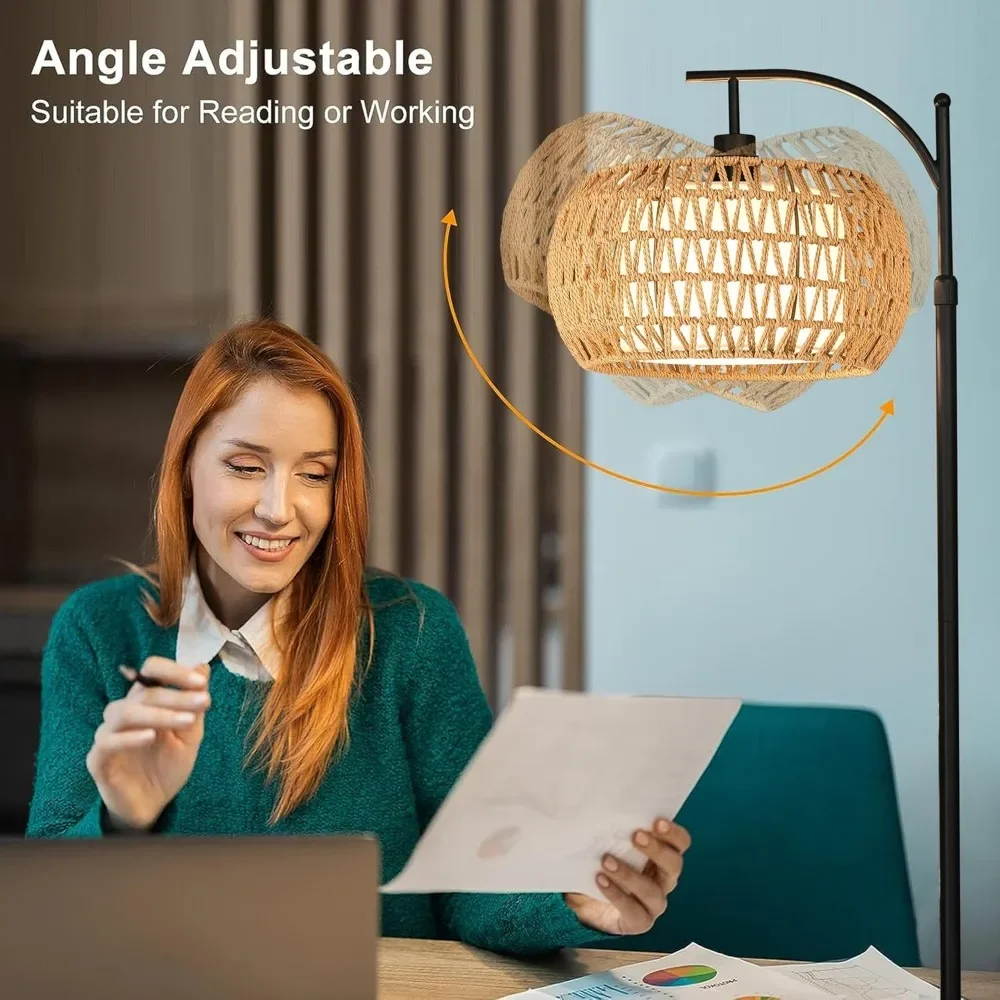
Traditional/Transitional Styles
These arc lamps blend classic elements with modern functionality:
* Drum shades in neutral fabrics
* Antique brass or bronze finishes
* Marble bases in classic colors
* More ornamental details compared to contemporary styles
These lamps bridge traditional and modern elements in eclectic or transitional homes.
Color and Finish Selection
When selecting colors and finishes:
* Match metal finishes with existing hardware in the room (door handles, faucets, etc.) for cohesion
* Consider contrast – a black lamp against a white wall creates dramatic impact
* For neutral rooms, metallic finishes like brass or copper can add warmth without overwhelming color
* In colorful rooms, choose lamp finishes that complement rather than compete with your palette
The key to successful style matching is considering your arc lamp as part of your overall design story. Whether you want it to blend seamlessly or serve as a focal point will guide your selection process.
Light Output and Bulb Selection
Understanding light output and selecting the right bulbs for your arc floor lamp significantly impacts both functionality and ambiance in your space. Modern lighting technology offers various options to customize the quality, intensity, and efficiency of your lamp’s illumination.
Understanding Light Measurements
Lumens vs. Watts: Lumens measure brightness (light output), while watts measure energy consumption. For example, a 60-watt incandescent bulb produces about 800 lumens, whereas an LED bulb can produce the same brightness using only 8-12 watts.
Light Requirements by Usage:
- Reading: 400-700 lumens
- Ambient room lighting: 1,000-3,000 lumens (varies by room size)
- Accent lighting: 200-400 lumens
Bulb Type Comparison
| Bulb Type | Lifespan (hours) | Energy Efficiency | Light Quality | Initial Cost | Long-term Cost |
|---|---|---|---|---|---|
| LED | 15,000-25,000 | Excellent | Consistent, available in various color temperatures | Higher | Lowest |
| Halogen | 2,000-4,000 | Moderate | Bright, white light with excellent color rendering | Moderate | Higher |
| Incandescent | 750-2,000 | Poor | Warm, natural light with perfect color rendering | Lowest | Highest |
LED arc floor lamps have become increasingly popular due to their significant advantages:
* Energy consumption 75-80% lower than incandescent bulbs
* Minimal heat production, making them safer for extended use
* Available in various color temperatures to suit different moods and activities
* Compatible with dimming technology (with compatible dimmers)
* Environmental benefits from reduced energy use and longer replacement intervals
Color Temperature Selection
Color temperature, measured in Kelvins (K), greatly affects the mood of your space:
Warm White (2700K-3000K): Creates cozy, relaxing environments ideal for living rooms and bedrooms. This temperature range resembles traditional incandescent lighting with a slightly yellowish glow.
Neutral White (3500K-4100K): Provides balanced lighting suitable for kitchens, home offices, and bathrooms. This range presents colors more accurately without strong yellow or blue tints.
Cool White (5000K+): Produces energizing, daylight-like illumination best for task-focused areas requiring high concentration. This bluer light helps maintain alertness but can feel harsh in relaxation spaces.
Bulb Shape Considerations
The shape of your bulb affects how light is distributed from your arc lamp:
- A19/A60 (Standard): The classic bulb shape, suitable for most lamp shades
- BR30/R80 (Reflector): Directs light downward, ideal for task lighting
- Globe: Provides even, omnidirectional light distribution
- Candle/Flame: More decorative, often used in exposed bulb designs
For arc lamps where the bulb is visible, decorative options like Edison-style bulbs can enhance the aesthetic appeal while still providing functional light.
When purchasing bulbs, check your lamp’s specifications for:
* Maximum wattage rating (never exceed this for safety)
* Socket type (typically E26/E27 in the US, E14/E27 in Europe)
* Dimmer compatibility if applicable
* Any size restrictions based on the shade design
Selecting the right bulb combination allows you to customize your arc lamp’s performance for both practical illumination and atmosphere creation.
Advanced Features and Functionality
Today’s arc floor lamps offer sophisticated features that enhance both their utility and user experience. Understanding these advanced options helps you select a lamp that provides maximum functionality for your specific needs.
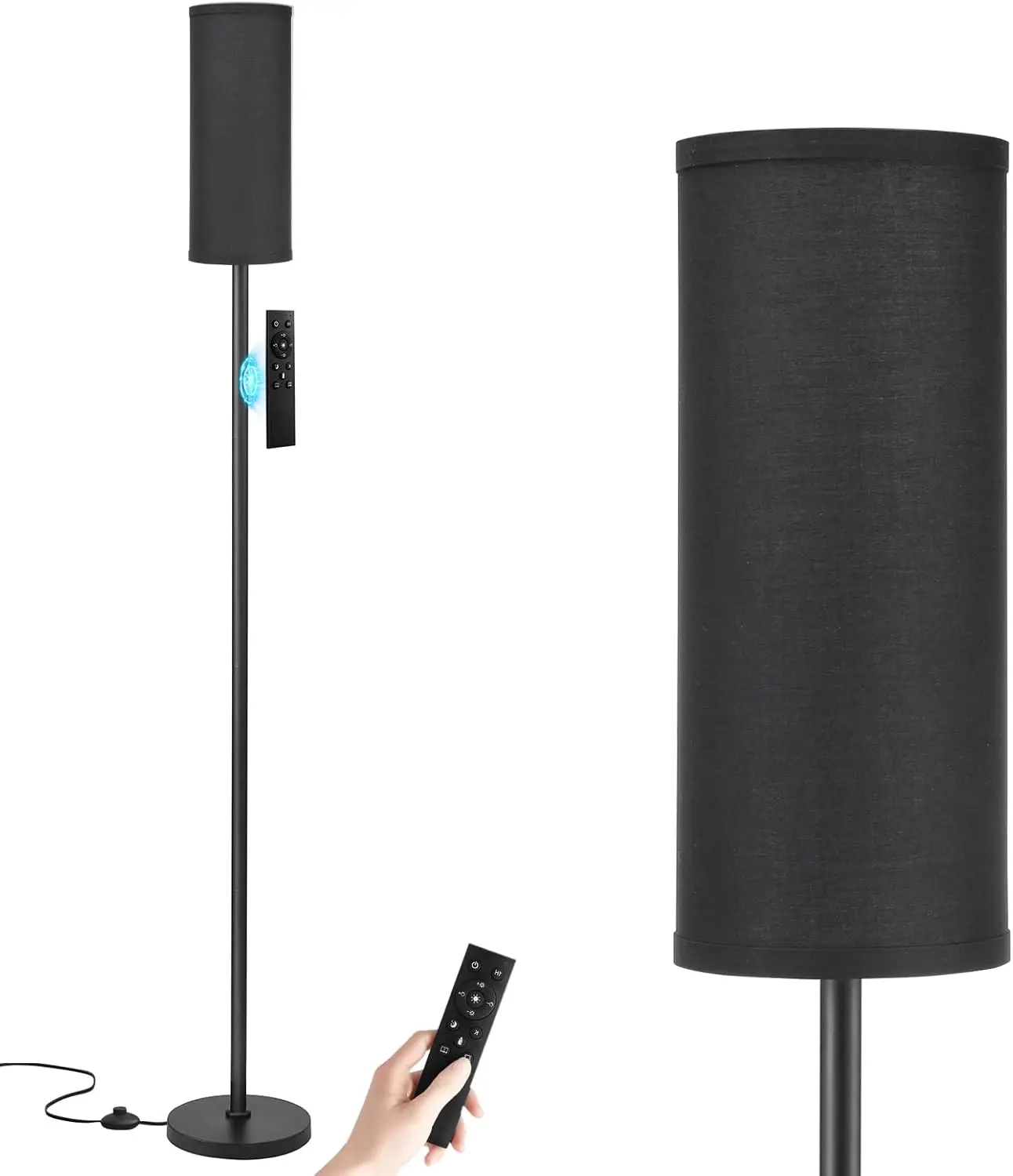
Adjustability Options
Modern arc lamps vary significantly in their flexibility and range of motion:
Height Adjustability: Some models feature telescoping poles or sliding mechanisms that allow you to change the overall height. Look for smooth operating mechanisms with secure locking features to prevent unwanted movement.
Arm Articulation: Adjustable arc floor lamps often feature joints or hinges that allow you to change the reach and angle of the light. High-quality lamps maintain their position without drooping and move smoothly when adjusted.
Rotating/Swiveling Heads: Many arc lamps include shade heads that rotate 180-360 degrees and tilt up/down, allowing precise light direction. This feature is particularly valuable for task lighting applications.
Extendable Arms: Some designs feature arms that can extend or retract to change the lamp’s reach, helpful in multipurpose rooms where lighting needs change based on activities.
Dimming Capabilities and Controls
Dimmable arc floor lamps provide versatility in setting the right ambiance and light level:
In-line Dimmers: Simple slider or rotary dimmers integrated into the lamp’s power cord offer basic brightness control.
Foot Switches: Convenient floor-mounted switches allow hands-free operation, particularly useful when the lamp is positioned behind furniture.
Touch Controls: Some contemporary models feature touch-sensitive panels on the base or arm for intuitive operation.
Remote Controls: Higher-end arc lamps often include remote controls that adjust brightness, color temperature, and sometimes even the color of the light from across the room.
Smart Home Integration: The most advanced models connect to home automation systems via WiFi or Bluetooth, allowing control through smartphone apps or voice commands through systems like Amazon Alexa or Google Home.
Multiple Light Configurations
Arc lamps are no longer limited to single-light designs:
Multi-head Options: Lamps with multiple arms or heads can illuminate different areas simultaneously or provide more substantial overall lighting.
Dual-functionality Designs: Some innovative models include both downward-facing task lighting and upward-facing ambient lighting in a single fixture, often with independent controls for each.
Integrated LED Arrays: Rather than traditional bulbs, some contemporary designs incorporate LED strips or panels that provide more even light distribution and unique lighting effects.
Specialized Features for Specific Uses
Reading-optimized Arc Lamps: Feature precise positioning options and appropriate brightness levels (400-700 lumens) for comfortable reading without eye strain.
Color Temperature Adjustment: Premium models allow you to change the color temperature from warm (2700K) to cool (5000K+) to suit different activities or times of day.
USB Charging Ports: Some contemporary arc lamps include integrated USB ports in the base, adding practical functionality for charging devices.
Memory Settings: Higher-end models can store preferred positions or brightness settings for quick access.
Contemporary Arc Floor Lamp, Large Arc Floor Lamp, Oversized Arched Floor Lamp
$460.63 Select options This product has multiple variants. The options may be chosen on the product pageAdjustable Arc Floor Lamp, Bronze Arc Floor Lamp
Price range: $440.95 through $558.52 Select options This product has multiple variants. The options may be chosen on the product pageBrass Arc Floor Lamp, Contemporary Arc Floor Lamp, LED Arc Floor Lamp
Price range: $490.72 through $522.04 Select options This product has multiple variants. The options may be chosen on the product pageChrome Arc Floor Lamp, LED Arc Floor Lamp
Price range: $304.95 through $1,210.40 Select options This product has multiple variants. The options may be chosen on the product pageContemporary Arc Floor Lamp, Large Arc Floor Lamp, Marble Base Arc Floor Lamp
$224.94 Select options This product has multiple variants. The options may be chosen on the product pageMid-Century Arc Floor Lamp, Wood Arc Floor Lamp
$230.86 Select options This product has multiple variants. The options may be chosen on the product page
When evaluating these features, consider your daily lighting needs and how you’ll interact with the lamp. While advanced features add convenience, they also increase complexity and potential maintenance requirements. The most important arc lamp features for your situation should align with how you’ll primarily use the lamp in your specific space.
Strategic Placement in Different Room Types
Where you position your arc floor lamp significantly impacts both its functionality and aesthetic contribution to your space. Different rooms have unique lighting requirements and spatial considerations that influence optimal placement.
Living Room Placement
Living rooms typically offer the most placement options for arc floor lamps:
Over Seating Areas: Position the lamp with its arc extending over a sofa or armchair, typically 24-36 inches (61-91 cm) from the seating surface. This creates perfect task lighting for reading without occupying table space.
Corner Installations: Placing the lamp in a corner allows the arc to extend into the room while minimizing the base’s footprint in high-traffic areas.
Conversation Areas: Center an arc lamp between facing seating to provide balanced illumination for everyone in the conversation group.
Behind Sofas: When space is limited, position the base behind a sofa with the arc extending over the seating area, creating the illusion of built-in lighting.
Living room arc lamp placement should complement other light sources like table lamps or recessed lighting to create a layered lighting effect.
Dining Area Strategies
Arc lamps offer an alternative to traditional pendant lights over dining tables:
Centered Installation: Position the lamp so the shade hangs 30-36 inches (76-91 cm) above the table surface and centered over the table.
Off-Center Placement: For rectangular tables, consider positioning the lamp toward one end rather than center, creating a more casual, asymmetrical look.
Clearance Considerations: Ensure the lamp allows for comfortable movement around the table without guests bumping their heads when standing up.
Bedroom Applications
In bedrooms, arc lamps serve both functional and atmospheric purposes:
Reading Nooks: Position the lamp to extend over a bedroom chair with the light directed downward for optimal reading conditions.
Bedside Alternative: An arc lamp can replace traditional bedside table lamps, arching over from behind the headboard or from the side, freeing up nightstand space.
Height Adjustment: In bedrooms, position the light lower than in public spaces for a more intimate feel.
Home Office Optimization
For productive work environments:
Over-Desk Positioning: Place the lamp so it extends over your work surface without creating screen glare. The light source should be positioned slightly behind and to the side of a computer monitor.
Ergonomic Considerations: Adjust the height so the bottom of the shade sits approximately 16-18 inches (40-46 cm) above your work surface.
Complementary Lighting: Use the arc lamp as task lighting while ensuring the room has adequate ambient lighting to reduce eye strain.
Solutions for Challenging Spaces
Small Rooms: Choose compact arc designs with shorter reaches and smaller shades. Consider models where the arc can be adjusted or rotated when not in use.
Low Ceilings: Select models with flatter arcs rather than high curves, or look for height-adjustable options.
Open Floor Plans: Use arc lamps to visually define separate functional areas within larger spaces.
Creating dedicated reading corners with arc lamps requires particular attention to light position. The bottom of the shade should be approximately 16-18 inches (40-46 cm) above reading material and positioned slightly to the side or behind the reader’s shoulder to prevent glare.
Common placement mistakes to avoid include:
* Positioning the lamp where the base becomes a tripping hazard in walkways
* Placing the lamp where the shade obstructs sightlines or views
* Installing the lamp too far from seating areas, rendering the light ineffective
* Neglecting to consider the arc’s reach relative to furniture placement
Arc Lamps vs. Other Lighting Solutions
Understanding how arc floor lamps compare to alternative lighting options helps determine if they’re truly the best solution for your specific needs. Each lighting type offers distinct advantages and limitations that make them suitable for different situations.
Comparative Advantages
| Lighting Type | Space Efficiency | Light Distribution | Installation | Flexibility | Price Range | Best Use Case |
|---|---|---|---|---|---|---|
| Arc Floor Lamp | High – only needs floor space for base | Directional, overhead | No installation required | Moderate to high depending on features | $150-$1000+ | Over seating or tables without ceiling fixtures |
| Traditional Floor Lamp | Moderate – vertical footprint | Upward, downward or diffused | No installation required | Low to moderate | $80-$500 | General ambient lighting, constrained spaces |
| Table Lamp | Low – requires table surface | Localized, limited range | No installation required | Low | $40-$300 | Bedside, accent lighting |
| Pendant Light | Very high – no floor space needed | Directional, focused downward | Permanent electrical installation | Very low | $100-$600+ | Fixed locations needing direct light |
| Torchiere Lamp | Moderate – vertical footprint | Upward, ceiling-bounced light | No installation required | Low | $70-$400 | Ambient lighting, small spaces |
| Tripod Floor Lamp | Low – wide base footprint | Varied depending on shade | No installation required | Low to moderate | $120-$600 | Design statement, stable lighting |
Key Advantages of Arc Floor Lamps
Overhead Light Without Installation: Arc lamps provide downward-directed light similar to pendants or ceiling fixtures without requiring electrical work or permanent installation.
Adjustable Positioning: Unlike fixed ceiling fixtures, arc lamps can be repositioned as furniture arrangements change or different activities require different lighting.
Space Efficiency: The arched design allows the light source to be positioned over furniture while keeping the base in a less obtrusive location, unlike traditional floor lamps that must stand directly beside seating.
Design Impact: Arc lamps often serve as sculptural elements and conversation pieces beyond their lighting function, adding architectural interest to rooms.
When Arc Lamps Excel
Arc floor lamps are particularly advantageous in:
- Rental properties where ceiling fixture installation isn’t permitted
- Rooms with concrete ceilings where installing electrical fixtures is challenging
- Spaces where furniture is frequently rearranged
- Areas requiring dramatic lighting without the permanence of installed fixtures
- Rooms where existing ceiling fixtures are poorly positioned for current furniture layout
When Another Solution Might Be Better
Other lighting options might be preferable when:
- Floor space is extremely limited (wall sconces or pendant lights might be better)
- Very high light output is needed to illuminate a large area (multiple ceiling fixtures)
- The primary need is for ambient rather than directed light (torchiere lamps)
- Lighting needs to be very precisely positioned for detailed tasks (desk lamps)
- Budget constraints are significant (table lamps typically cost less)
The comprehensive comparison of lighting options reveals that arc lamps occupy a unique middle ground between portable lighting fixtures and installed overhead lighting. This versatility makes them particularly valuable in spaces that need both flexibility and the directed quality of overhead lighting.
Budget Considerations and Investment Value
Arc floor lamps span a wide price spectrum, with significant variations in quality, features, and design sophistication across different price points. Understanding what you get at each investment level helps you make a choice that balances budget with long-term satisfaction.
Price Range Breakdown
Entry-Level Arc Lamps ($100-$200)
* Basic construction with lighter-weight materials
* Simple designs with limited or no adjustability
* Often feature plastic components in less visible areas
* Typically non-dimmable with basic on/off switches
* May have less stable bases or thinner metal in the arc
* Suitable for temporary situations or less-frequented spaces
Mid-Range Options ($200-$500)
* Improved stability with heavier bases
* Better finishing quality and more precise manufacturing
* Some adjustable features like height or head position
* More diverse style options and material combinations
* Often include dimming capabilities
* Represents the best value for most households
Premium Selections ($500+)
* Superior materials like solid marble bases or premium metals
* Sophisticated engineering allowing smooth adjustments
* Distinctive designer aesthetics or innovative features
* Advanced control options including remotes or smart functionality
* Precision manufacturing with excellent attention to detail
* Built to last with replaceable parts and timeless designs
Long-Term Value Assessment
When evaluating the long-term value of an arc lamp investment, consider:
Durability Factors: Higher-quality lamps use thicker gauge metals, better wiring, and more robust adjustment mechanisms that withstand regular use without failing.
Timelessness of Design: Classic designs like marble-based arc lamps or simple contemporary styles tend to remain visually relevant longer than highly trendy options.
Maintenance Requirements: Better lamps use finishes less prone to showing fingerprints or collecting dust, and have parts that can be cleaned without damage.
Versatility: More versatile lamps with adjustable features adapt to changing needs and room arrangements, extending their useful life.
Beyond Purchase Price
The total cost of ownership includes:
Energy Efficiency: LED-compatible fixtures offer significant long-term savings. A quality LED bulb uses approximately 75% less energy than an incandescent equivalent and lasts up to 25 times longer. This can translate to $10-30 annual savings per lamp in electricity costs.
Bulb Replacement: Consider frequency and cost of replacement bulbs. Premium fixtures often accept a wider range of bulb types, allowing you to upgrade as technology improves.
Repair vs. Replace: Higher-quality lamps often have replaceable parts, allowing repair rather than complete replacement if something breaks.
The comprehensive arc lamp buying guide suggests that the sweet spot for most consumers lies in the mid-range category, where meaningful quality improvements justify the price increase over budget options. However, if the lamp will be a central design feature in a frequently used space, the premium category offers distinctive aesthetics and superior functionality that can justify the higher investment.
For specialized situations:
* Small apartments might benefit from multi-function premium lamps that combine ambient and task lighting
* Design-focused homes might justify investment in iconic designs with lasting value
* High-traffic areas benefit from sturdier construction of mid to premium options
Stability, Safety, and Practical Considerations
Beyond aesthetics and features, practical considerations like stability and safety significantly impact your long-term satisfaction with an arc floor lamp. These factors become especially important given the unique cantilever design of arc lamps, which creates different physical stresses than traditional floor lamps.
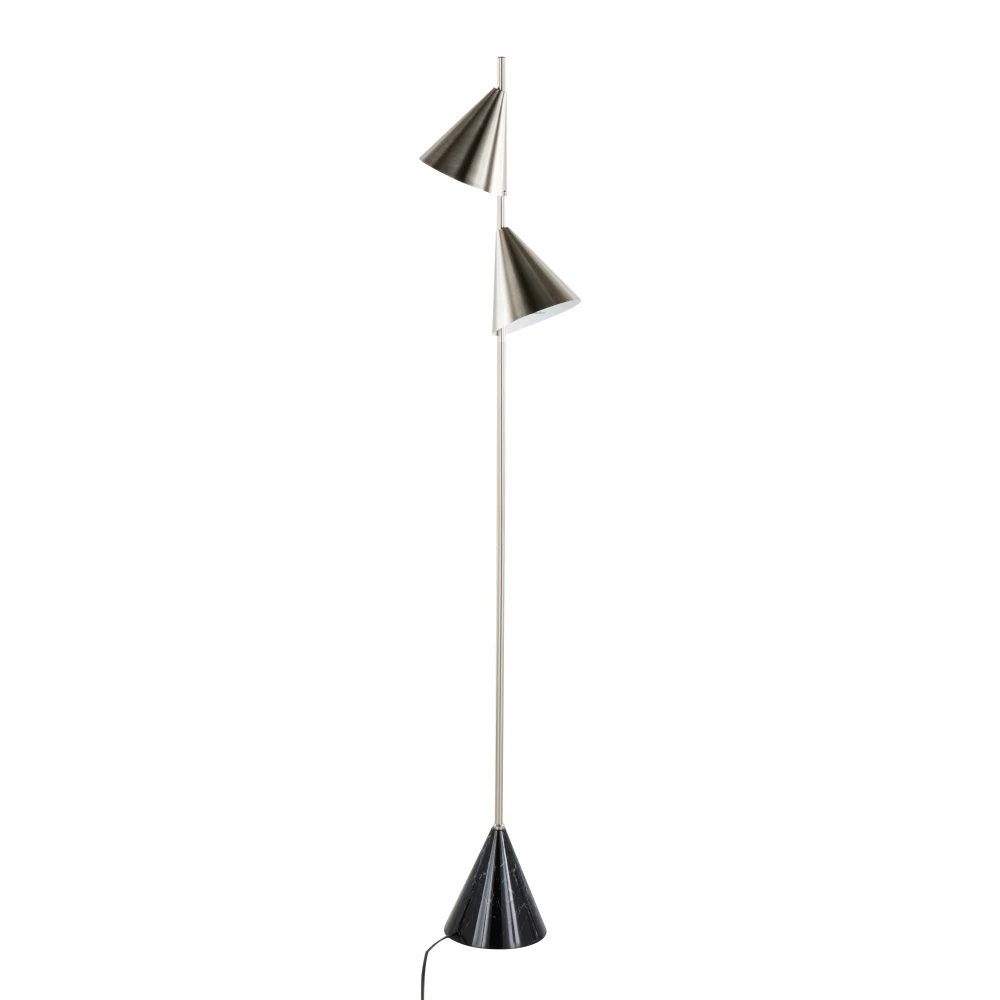
Critical Stability Factors
The stability of an arc lamp depends primarily on the relationship between the base weight and the arc length:
Base Weight Requirements: As a general rule, the longer the arc, the heavier the base needs to be. A properly designed lamp with a 30-inch arc typically requires a base weighing at least 15-20 pounds (6.8-9 kg), while longer arcs need proportionally heavier bases.
Center of Gravity: Quality arc lamps are engineered with careful attention to the center of gravity. The base should be weighted toward the side opposite the arc extension to counterbalance the suspended lamp head.
Base Design: Beyond just weight, the shape and dimensions of the base affect stability. Wider bases with lower profiles generally provide better stability than taller, narrower designs with the same weight.
Tip-over Resistance: Test an assembled lamp by gently pushing the shade from different angles to ensure it doesn’t easily tilt or topple. The importance of a properly designed base cannot be overstated for both safety and peace of mind.
Electrical Safety Considerations
Electrical safety is paramount with any lighting fixture:
Certification Standards: Look for UL (Underwriters Laboratories) or ETL (Electrical Testing Labs) certifications, which indicate the lamp meets established safety standards.
Cord Quality: Quality lamps feature thick, flexible cords with durable insulation and strain relief where the cord exits the lamp. The cord should be long enough (usually 6-9 feet) to reach outlets without creating tension.
Heat Management: Check that the lamp shade and housing around the bulb socket have adequate ventilation and heat-resistant materials. This is especially important for halogen bulbs, which generate significant heat.
Polarized Plugs: Better-quality lamps feature polarized or three-prong grounded plugs for added electrical safety.
Child and Pet Safety
For households with children or pets:
Stable Positioning: Place arc lamps away from play areas and high-traffic zones to reduce collision risk.
Cord Management: Use cord covers or furniture arrangements that conceal cords to prevent tripping or pulling hazards.
Heat Protection: If using halogen bulbs, ensure the lamp head is positioned well out of reach to prevent burn risks.
Heavy Base Caution: While stability is important, very heavy bases can cause injury if toppled. Consider securing extremely heavy lamps to walls in homes with active children.
Assembly and Maintenance Practicalities
Practical considerations for day-to-day use include:
Assembly Complexity: Some arc lamps arrive fully assembled, while others require significant assembly. Check reviews or product descriptions for assembly difficulty and expected time investment.
Tool Requirements: Quality lamps typically include any specialized tools needed for assembly, while budget options might require your own tools.
Adjustment Mechanisms: Test all moving parts during assembly to ensure smooth operation and proper tightening.
Moving Considerations: Arc lamps can be awkward to move due to their shape and weight distribution. Consider how often you might need to reposition the lamp and how easily it can be disassembled if necessary.
By prioritizing these stability and safety factors, you ensure your arc lamp will not only look beautiful but also function reliably and safely for years to come.
Ongoing Maintenance and Care
Proper maintenance extends the life of your arc floor lamp while keeping it looking and functioning at its best. Different materials require specific care approaches to preserve their appearance and integrity.
Material-Specific Cleaning Guidelines
Marble and Stone Bases
* Clean with a soft, slightly damp cloth and mild soap if necessary
* Avoid acidic cleaners (including vinegar) which can etch the surface
* Apply stone sealer annually to prevent staining on porous stone
* Use coasters under drinks placed near marble bases
* Clean spills immediately to prevent absorption and staining
Metal Finishes
* Brushed metals: Wipe with a soft cloth following the grain direction; use mild soap for stubborn dirt
* Polished metals: Use specialized metal polishes appropriate for the specific finish (brass, chrome, etc.)
* Painted metals: Clean with a slightly damp cloth and mild soap; avoid abrasive cleaners
* Prevent fingerprints on highly polished surfaces by handling with clean hands or cotton gloves
* Apply a thin coat of appropriate metal wax on brass or copper finishes to slow tarnishing
Fabric Shades
* Dust regularly with a soft brush attachment on a vacuum cleaner
* Spot clean stains with a mild soap solution and clean cloth
* Allow fabric shades to dry completely before reattaching to the lamp
* Avoid using water on paper or parchment shades
* Consider professional cleaning for valuable or delicate fabric shades
Glass Components
* Clean with glass cleaner and a lint-free cloth
* For textured glass, use a soft brush to reach crevices
* Ensure glass is completely dry before reassembling
* Handle carefully during cleaning to avoid dropping
Bulb Replacement Procedures
When replacing bulbs in arc floor lamps:
* Always unplug the lamp and allow it to cool completely
* Check the maximum wattage rating and never exceed it
* Handle new bulbs with clean hands or gloves to prevent oils from transferring to the glass
* Ensure the bulb is securely installed but not overtightened
* Test the new bulb immediately to confirm proper installation
For hard-to-reach bulbs in tall arc lamps, consider:
* Using a step stool or ladder on level ground
* Having someone steady the lamp while you work
* Switching to longer-lasting LED bulbs to reduce replacement frequency
Common Troubleshooting
For wobbly lamps:
* Check that all connecting parts are properly tightened
* Ensure the lamp is on a completely level surface
* Verify that the weighted base is positioned correctly (heavier side opposing the arc)
* Check for damaged or bent components that may need replacement
For electrical issues:
* Inspect cords for damage or fraying
* Test bulbs in other working lamps to rule out bulb failure
* Check that dimmer switches are compatible with the bulb type
* Ensure all connections are secure and clean
Warning signs that indicate potential electrical problems include:
* Flickering that persists after bulb replacement
* Unusual buzzing or humming sounds
* Discoloration around sockets or switches
* Burning smells or excessive heat
* Circuit breakers tripping when the lamp is used
The maintenance requirements of modern arc lamp designs are generally minimal, typically requiring just 5-10 minutes monthly for dusting and occasional deeper cleaning. However, proper care significantly extends the lamp’s lifespan and preserves its appearance, making this small time investment worthwhile.
Answering Common Questions About Arc Floor Lamps (FAQ)
Can arc floor lamps work in small apartments?
Yes, arc floor lamps can work exceptionally well in small apartments when properly sized. Look for models with shorter arcs (24-30 inches rather than 40+ inches) and smaller shade diameters. Arc lamps actually save space compared to traditional floor lamps because their base can be positioned behind furniture while the light extends over your seating or work area. This eliminates the need for end tables and table lamps, freeing up valuable surface space in compact living environments.
How do I know if my floor lamp is providing enough light?
Your arc lamp provides adequate light if you can comfortably perform intended activities without eye strain. For reading, you should have 400-700 lumens directed at your reading material without creating harsh shadows or glare. For ambient lighting, the lamp should provide even illumination across the target area. If you find yourself squinting or experiencing eye fatigue, your lamp may be insufficient for your needs. Consider higher lumen output bulbs or supplementing with additional light sources for larger rooms.
Are arc lamps suitable for low ceilings?
Arc lamps can work with low ceilings if you select models with flatter, less dramatic arcs. Look for lamps with arcs that extend outward more than upward, and ensure there’s at least 12 inches (30 cm) clearance between the highest point of the lamp and your ceiling. Some models feature adjustable heights that can be customized for lower ceilings. Position the lamp so the arc runs parallel to walls rather than extending into the center of small rooms with low ceilings.
Can I replace just the shade on my arc lamp?
In many cases, yes. Many arc lamps use standard shade mounting systems. Measure your existing shade dimensions and attachment method before purchasing a replacement. For proprietary designs, contact the manufacturer about replacement options. When choosing between single or multi-arm designs, remember that specialized multi-arm shades may be more difficult to replace if damaged.
Do all arc lamps require assembly?
Most arc lamps require some assembly, though the complexity varies widely. Higher-end models typically feature simpler assembly with fewer parts and included tools. Basic assembly usually involves attaching the arc to the base, connecting electrical components, and attaching the shade. Allow 15-45 minutes for typical assembly. Some premium models arrive fully assembled or require minimal setup. Always follow manufacturer instructions carefully, as improper assembly can affect stability.
How do I stop my arc lamp from wobbling?
To stabilize a wobbling arc lamp, first ensure it’s on a completely level surface. Check that all connections are properly tightened, particularly where the arc meets the base. Verify the lamp is properly balanced with the weighted portion of the base positioned opposite the direction of the arc. Some models include leveling feet that can be adjusted for stability. For persistent wobbling, place a thin non-slip pad under the base or consider adding weight to the base if the design allows.
Can I use smart bulbs in arc floor lamps?
Smart bulbs generally work well in arc floor lamps, provided they fit physically and don’t exceed the lamp’s maximum wattage rating. Smart bulbs offer convenient control through smartphone apps or voice assistants and can transform even basic arc lamps into programmable fixtures with dimming and color-changing capabilities. Ensure the lamp’s switch remains in the “on” position for smart functionality to work. Note that some smart bulbs are heavier than standard bulbs, so verify the socket can support the weight.
Styling Tips from Interior Design Professionals
Professional interior designers use arc floor lamps as versatile design elements that can dramatically transform a space. Their strategic approach to lamp placement and selection can help you maximize both the functional and aesthetic impact of your arc lamp.
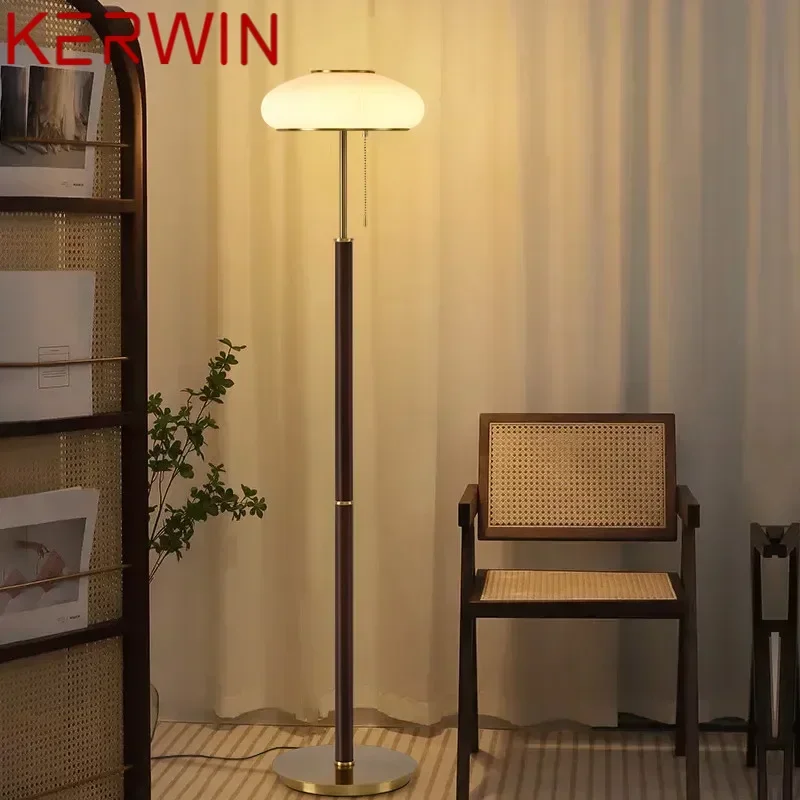
Creating Visual Balance with Asymmetrical Designs
Counterbalance Principle: When using a dramatically curved arc lamp, balance it with visually “heavier” furniture on the opposite side of the room to create equilibrium.
Height Variation: Position arc lamps to add height variation in rooms with predominantly low furniture, drawing the eye upward and creating visual interest.
Scale Coordination: Match the scale of your arc lamp to your primary furniture pieces—larger, more substantial seating arrangements pair with bolder lamp designs, while delicate furniture calls for more restrained lamp proportions.
Negative Space: Don’t be afraid of allowing empty space around an arc lamp; this negative space highlights its sculptural quality and prevents visual crowding.
Coordinating with Other Lighting Elements
- Layered Lighting: Interior designers recommend incorporating arc lamps within a three-layer lighting approach:
- Ambient lighting (general illumination)
- Task lighting (focused light for specific activities)
Accent lighting (highlighting architectural features or decor)
Finish Consistency: While exact matching isn’t necessary, coordinate metal finishes on your arc lamp with at least one other metal element in the room for cohesion.
Light Temperature Harmony: Ensure all light sources in a room have similar color temperatures (measured in Kelvins) to create a harmonious environment. Mix warm light sources (2700K-3000K) together, or cool sources (3500K-5000K) together, but avoid mixing temperature extremes.
Defining Zones in Open Spaces
Visual Boundaries: Use arc lamps to establish distinct functional areas within open floor plans—positioning an arc lamp over a reading chair immediately defines a reading nook without physical barriers.
Directional Guidance: Place arc lamps to subtly direct traffic flow through larger spaces, guiding movement paths naturally around conversation areas.
Activity Centers: Position the lamp to highlight activity centers, using the pool of light to draw attention to important areas like conversation groupings or work surfaces.
Creative Applications
Interior designers from Interior Ivy recommend these creative approaches to matching arc lamps with your furniture:
Unexpected Pairings: Try an ultra-modern arc lamp with traditional furniture for an eclectic look, or a vintage-inspired lamp in minimalist surroundings for character.
Color Contrast: Choose a lamp finish that contrasts with your color scheme to create a focal point—black metallic lamps pop against light walls, while brass finishes warm up cool color palettes.
Seasonal Flexibility: Reposition arc lamps seasonally to accommodate changing needs—closer to seating during winter months for reading, or angled to avoid adding heat during summer months.
Multi-purpose Illumination: Position arc lamps where they can serve dual purposes, such as illuminating both a sofa for reading and highlighting artwork on an adjacent wall.
Common Styling Mistakes to Avoid
Competing Focal Points: Avoid placing arc lamps near other dramatic design elements where they’ll compete for attention.
Improper Scaling: Oversized arc lamps in small rooms or delicate models in grand spaces create proportion problems.
Isolated Placement: Arc lamps should relate to furniture arrangements rather than standing alone.
Over-illumination: Using too many statement lighting pieces in one space dilutes their individual impact.
By applying these professional styling principles, your arc floor lamp can become more than just a light source—it becomes an integral part of your overall interior design strategy, enhancing both the functionality and aesthetic appeal of your space.

